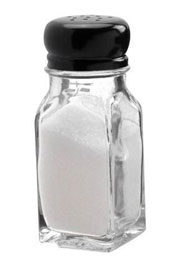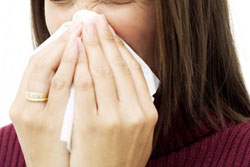- What is nasal irrigation?
- Does nasal irrigation work?
- How saline nasal irrigation works
- Who should use nasal irrigation?
- Salt water nasal wash recipe
- Using nasal spray correctly
- Correct nose blowing technique
What is nasal irrigation?
Nasal irrigation (washing the nasal cavity with fluid) using sprays and washes has been used to remedy symptoms of colds and flus, and other conditions affecting the nose, for centuries. The practice is thought to originate from traditional Indian medical practice called Ayurvedic medicine.
Nasal irrigation can be used to remedy cold and flu symptoms like a blocked nose and is usually used in conjunction with other cold and flu remedies or treatments.
Does nasal irrigation work?
Although people have been using nasal irrigation for centuries, there is little evidence from scientific studies to show whether or not it is actually works as a method for relieving cold and flu symptoms like blocked nose.
Some scientific studies have shown it is effective in relieving symptoms of the nose associated with other conditions such as chronic sinusitis and allergic rhinitis (hayfever). But the studies that have been conducted to test the effectiveness of saline (salt water) nasal irrigation have shown no benefit or only minor benefit (e.g. a shorter duration of time off work of 0.3 days) for cold and flu symptoms.
Doctors have raised concerns about homemade solutions containing salt and baking soda which remain unproven. There are also concerns about commercially prepared nasal sprays and washes containing benzalkonium chloride, which may make infections or the symptoms they cause worse.
Salt water solutions which do not contain baking soda are generally considered safe to use and probably have mild benefits for upper respiratory tract infections like cold and flu.
Although there is a need for better evidence, some doctors still recommend a traditional homemade nasal wash for relieving congestion and blocked nose when you have a cold or flu. However, they recommend the solution is made using just salt and water, and not baking soda and putting less salt in the mix than has traditionally been used. The salt content of the solution may vary from 0.9% which is similar to the salt concentration in body fluid, to slightly salty (2-3% salt concentration).
How saline nasal irrigation works
Saline nasal irrigation increases mucus clearance by stimulating the movement of cilia, which are the small hairs that push mucus out of the nose. It also moisturises the nasal passages and clears crusts of mucus (bogeys/dried snot) from the nose. This prevents bacteria building up under the crusts.
Get on top of your general health
Find and instantly book affordable GPs within Australia
Who should use nasal irrigation?
Most studies of salt water nasal washes have been conducted amongst adults. They show that the majority of adults can tolerate using salt water nasal wash. However, around 1 in 10 experience pain or irritation from using a wash with 0.9% salt concentration, as do up to one third of those using solutions containing 2-3% salt. The adults in these studies did not experience any serious side effects.
Children may also find saline irrigation a beneficial remedy. But a large proportion of babies (40% in one study) don’t tolerate the treatment.
Salt water nasal wash recipe
You can make a salt water solution 
Utensils
You will need the following equipment to prepare a saline irrigation solution:
- Measuring cup or jug
- Measuring teaspoon
- Sterile jar with lid
- Clean pot with lid
- Clock or kitchen timer
Ingredients
You will need the following ingredients to make the solution:
- Table salt (not iodised)
- Tap water
Method
To make the salt water nasal irrigation solution:
- Wash your hands by lathering with soap and rinsing with running water.
- Ensure the utensils you will use are clean and the jar that will be used for storing the nasal irrigation solution has been sterilised. You can sterilise the jar by boiling it for at least fifteen minutes and then being careful not to touch the inside or lid with your hands- even if you’ve washed them they may still have some germs that can contaminate the bottle.
- Add one litre (or 4 cups) of tap water to the pan using the measuring cup or jug. Alternatively you could use distilled water. Typically, treated water supplies are considered safe for preparing nasal irrigation solutions (even without boiling); surface water (e.g. from a river) should never be used.
- Add two level teaspoons of table salt to make a 0.9% salt irrigation solution. The salt should not be fortified with iodine. Iodised salt is more likely to cause irritation. Additional salt may be added to make the solution slightly hypertonic (2-3% salt concentration).
- Cover the pan with the lid and bring the water and salt solution to the boil.
- Boil for 15 minutes without removing the lid.
- Leave the pan to cool to room temperature with the lid on.
- Transfer the solution to the sterile jar and put the lid on.
- Label the jar with the data and time at which you made the saline.
- Label the jar with information about when the solution should be discarded. If you keep it in the jar and do not break the seal it will store safely for 30 days. Once you break the seal on the jar, the solution should be used or discarded within 48 hours.
Using nasal spray correctly
There are several different techniques which are effective for administering nasal washes. You’ll need about 1-2 cups of solution and can wash your nose once or twice a day, or when you feel you need to.
Hygiene and safety measures
Hygiene and safety measures are important when performing nasal irrigation, regardless of the technique you choose to get the solution into your nose. Hygiene and safety measures which should be taken include:
- If irritation occurs while using a 2-3% solution, reduce the amount of salt added to the recipe;
- Do not use very hot or very cold irrigation solution as it may cause irritation;
- Ensure the nasal wash solution is stored in a sterile jar, clearly labelled with a discard date;
- Be aware that temporary stinging may occur when the saline solution comes into contact with your nose and this is normal;
- Ensure the utensils you use for administering the wash are cleaned every time you use them to wash your nose;
- If you use an irrigation pot or bulb syringe to perform the nasal wash, ensure that each member of your family who needs to use one has their own pot or syringe, so you don’t accidently share your cold and flu germs;
- Pay careful attention to hand washing before and after performing nasal irrigation (in fact this is an important measure for all practices which cause you to touch your face), so that you reduce the likelihood of spreading cold and flu germs;
- Be aware that the salt water solution may drip from your nose to your mouth and leave a salty after taste. Rinse your mouth with water if this occurs.
Bulb syringe

- Ensure the bulb and syringe are clean and dry.
- Remove the required amount of salt water solution from the sterile container you’ve stored it in and pour it into a container you will use for filling the syringe with the solution. Never put the syringe into the sterile container in which the salt water solution is stored as you may also be adding a few cold and flu germs to the solution.
- Press firmly on the bulb to force the air out of the syringe. Place the syringe into the separate container of irrigation solution that you have prepared and release the bulb to suction the solution into the syringe.
- Tilt your head over a sink, so that when the syringe it inserted into one nostril, it will be in a horizontal position.
- Insert the syringe gently into one nostril while holding it parallel to the floor.
- Pump the bulb gently a couple of times to wash the nostril gently.
- Pump the bulb firmly enough that the solution fills up the nose and excess solution is forced into the mouth.
- Blow your nose to remove mucus and excess solution.
- Repeat the procedure for the other nostril.
- Clean the bulb syringe and leave it to dry when finished.
Inhaling solution from the palm
To perform nasal irrigation by inhaling solution from the palm of the hand:
- Wash your hands before touching your nose or face;
- Lean over the sink to perform the irrigation;
- Pour some of the salt water solution into the cup palm of one hand;
- Bend forward so your nose reaches your hand and gently inhale the solution through one nostril and then the other;
- Spit out any excess solution;
- Blow the nose gently, using the correct blowing technique (clearing both nostrils gently at the same time).
The bottle or dish you used to hold the salt water solution should be cleaned after each use.
Nasal irrigation pot
A nasal irrigation pot is a pot with a spout that is especially designed to make irrigating the nose easier. To wash your nose using an irrigation pot:
- Ensure the irrigation pot is clean and dry;
- Fill the pot with the salt water solution;
- Lean over a sink with your head tilted at about 45o, so that one nostril is on top of the other;
- Insert the spout of the pot gently into your uppermost nostril so that it forms a seal. The septum (cartilage that separates the nostrils) should be avoided and the pot should seal comfortably to your nose;
- While breathing gently through your mouth, raise the irrigation pot so that the solution pours into your upper nostril. The solution will begin draining from your lower nostril after a moment;
- Hold the irrigation pot in the pouring position until it is empty;
- Remove the irrigation pot from your nostril;
- Blow your nose gently to remove mucus and excess solution;
- Refill the nasal pot and repeat the procedure for the other nostril;
- Wash the irrigation pot when finished.
More information
 |
For more information on the common cold and influenza, types of influenza and treatments and tips for preventing influenza, see Cold and Flu. |
References
- Simon H. Colds and the Flu. University of Maryland Medical Centre. 2013. [cited 25 July 2013]. Available from: [URL Link]
- University of Wisconsin- Department of Family Medicine. Nasal irrigation (nasal wash) for common upper respiratory conditions. 2013. [cited 26 July 2013]. Available from: [URL Link]
- Kassel JC, King D, Spurling GKP. Saline nasal irrigation for acute upper respiratory tract infections. Cochrane Database of Systematic Reviews. 2010, Issue 3. Art. No.: CD006821. DOI: 10.1002/14651858.CD006821.pub2. [Full Text]
- Pinnonen M. Saline Nasal Sprays and Irrigation. University of Michigan Health Service. 2011. [cited 25 July 2013]. Available from: [URL Link]
- Slapak I, Skoupa J, Strnad P, et al. Efficacy of isotonic nasal wash (sea water) in the treatment and prevention of rhinitis in children. Arch Otolaryngol Head Neck Surg. 2008. 134(1): 67-74. [Abstract]
- Ohio State University Medical Centre. How to make normal saline. 2004. [cited 26 July 2013]. Available from: [URL Link]
- University of Carolina Student Health. Instruction sheet- nasal wash treatment. 2012. [cited 26 July 2013]. Available from: [URL Link]
- University of Wisconsin- Department of Family Medicine. Nasal irrigation instructions. 2012. [cited 26 July 2013]. Available from: [URL Link]
- Centres for Disease Control and Prevention. Preventing the flu- good health habits can help stop germs. 2013. [cited 14 April 2013]. Available from: [URL Link]
- Ohio State University Medical Centre. How to sterilise equipment. 2002. [cited 4 August 2013]. Available from: [URL Link]
All content and media on the HealthEngine Blog is created and published online for informational purposes only. It is not intended to be a substitute for professional medical advice and should not be relied on as health or personal advice. Always seek the guidance of your doctor or other qualified health professional with any questions you may have regarding your health or a medical condition. Never disregard the advice of a medical professional, or delay in seeking it because of something you have read on this Website. If you think you may have a medical emergency, call your doctor, go to the nearest hospital emergency department, or call the emergency services immediately.








